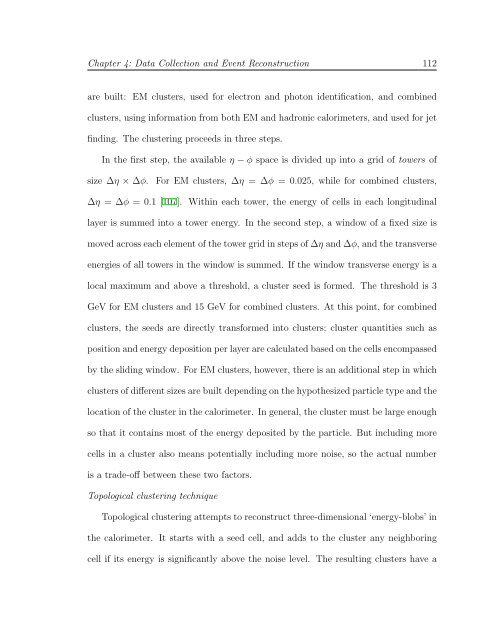Measurement of the Z boson cross-section in - Harvard University ...
Measurement of the Z boson cross-section in - Harvard University ...
Measurement of the Z boson cross-section in - Harvard University ...
Create successful ePaper yourself
Turn your PDF publications into a flip-book with our unique Google optimized e-Paper software.
Chapter 4: Data Collection and Event Reconstruction 112<br />
are built: EM clusters, used for electron and photon identification, and comb<strong>in</strong>ed<br />
clusters, us<strong>in</strong>g <strong>in</strong>formation from both EM and hadronic calorimeters, and used for jet<br />
f<strong>in</strong>d<strong>in</strong>g. The cluster<strong>in</strong>g proceeds <strong>in</strong> three steps.<br />
In <strong>the</strong> first step, <strong>the</strong> available η − φ space is divided up <strong>in</strong>to a grid <strong>of</strong> towers <strong>of</strong><br />
size ∆η × ∆φ. For EM clusters, ∆η =∆φ =0.025, while for comb<strong>in</strong>ed clusters,<br />
∆η =∆φ =0.1 [107]. With<strong>in</strong> each tower, <strong>the</strong> energy <strong>of</strong> cells <strong>in</strong> each longitud<strong>in</strong>al<br />
layer is summed <strong>in</strong>to a tower energy. In <strong>the</strong> second step, a w<strong>in</strong>dow <strong>of</strong> a fixed size is<br />
moved a<strong>cross</strong> each element <strong>of</strong> <strong>the</strong> tower grid <strong>in</strong> steps <strong>of</strong> ∆η and ∆φ, and <strong>the</strong> transverse<br />
energies <strong>of</strong> all towers <strong>in</strong> <strong>the</strong> w<strong>in</strong>dow is summed. If <strong>the</strong> w<strong>in</strong>dow transverse energy is a<br />
local maximum and above a threshold, a cluster seed is formed. The threshold is 3<br />
GeV for EM clusters and 15 GeV for comb<strong>in</strong>ed clusters. At this po<strong>in</strong>t, for comb<strong>in</strong>ed<br />
clusters, <strong>the</strong> seeds are directly transformed <strong>in</strong>to clusters; cluster quantities such as<br />
position and energy deposition per layer are calculated based on <strong>the</strong> cells encompassed<br />
by <strong>the</strong> slid<strong>in</strong>g w<strong>in</strong>dow. For EM clusters, however, <strong>the</strong>re is an additional step <strong>in</strong> which<br />
clusters <strong>of</strong> different sizes are built depend<strong>in</strong>g on <strong>the</strong> hypo<strong>the</strong>sized particle type and <strong>the</strong><br />
location <strong>of</strong> <strong>the</strong> cluster <strong>in</strong> <strong>the</strong> calorimeter. In general, <strong>the</strong> cluster must be large enough<br />
so that it conta<strong>in</strong>s most <strong>of</strong> <strong>the</strong> energy deposited by <strong>the</strong> particle. But <strong>in</strong>clud<strong>in</strong>g more<br />
cells <strong>in</strong> a cluster also means potentially <strong>in</strong>clud<strong>in</strong>g more noise, so <strong>the</strong> actual number<br />
is a trade-<strong>of</strong>f between <strong>the</strong>se two factors.<br />
Topological cluster<strong>in</strong>g technique<br />
Topological cluster<strong>in</strong>g attempts to reconstruct three-dimensional ‘energy-blobs’ <strong>in</strong><br />
<strong>the</strong> calorimeter. It starts with a seed cell, and adds to <strong>the</strong> cluster any neighbor<strong>in</strong>g<br />
cell if its energy is significantly above <strong>the</strong> noise level. The result<strong>in</strong>g clusters have a















